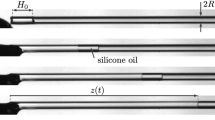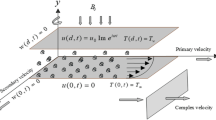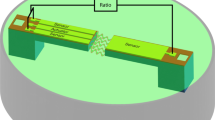Abstract
WHEN a capillary-tube viscometer is used for determining the apparent viscosity of a suspension of discrete, solid particles in a liquid, it is found that the measured viscosity varies with the bore of the capillary, increasing with increasing diameter. This effect, termed the sigma phenomenon, has been investigated by several workers, but in particular by Vand1 and de Bruijn2, both of whom examined the rheological properties of suspensions of spherical glass particles in liquids inert to glass.
This is a preview of subscription content, access via your institution
Access options
Subscribe to this journal
Receive 51 print issues and online access
$199.00 per year
only $3.90 per issue
Buy this article
- Purchase on SpringerLink
- Instant access to full article PDF
Prices may be subject to local taxes which are calculated during checkout
Similar content being viewed by others
References
Vand, V., J. Phys. Coll. Chem., 52, 277 (1948).
De Bruijn, H., paper presented at a joint meeting of the Chemical Society and the British Rheologists Club, May 1949. For report of meeting, see Nature, 164, 220 (1949).
Dix, A., and Scott Blair, G. W., J. App. Phys., 11, 574 (1940).
Whitmore, R. L., and Ward, S. G., Brit. J. App. Phys., 1, 286 (1950).
Author information
Authors and Affiliations
Rights and permissions
About this article
Cite this article
EVESON, G., WHITMORE, R. & WARD, S. Use of Coaxial-Cylinder Viscometers and Capillary-Tube Viscometers for Suspensions. Nature 166, 1074 (1950). https://doi.org/10.1038/1661074a0
Issue date:
DOI: https://doi.org/10.1038/1661074a0



